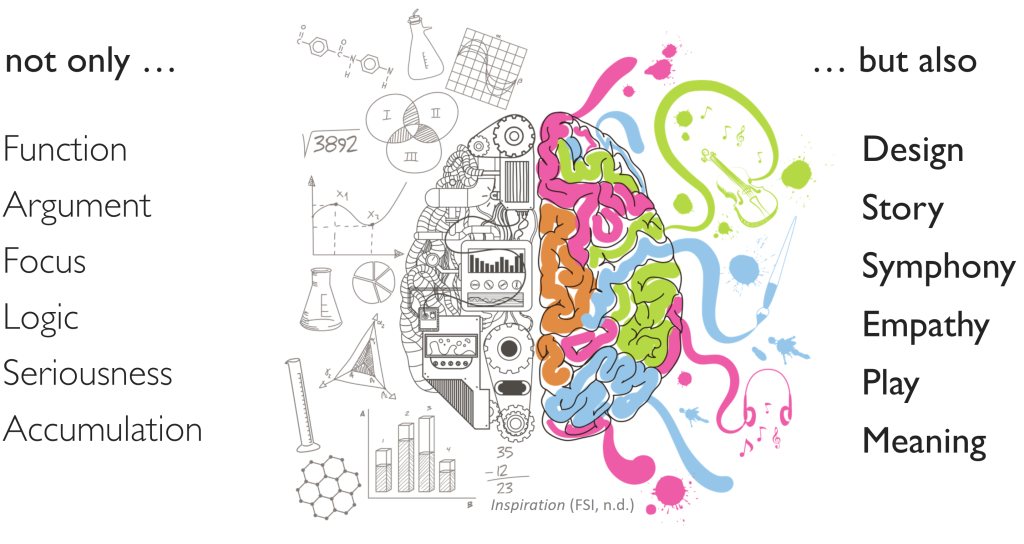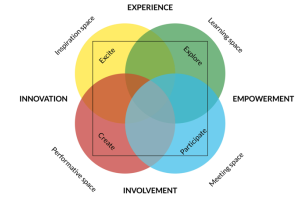
These six words were introduced in the lecture on the Hyperlinked Library Model (Stephens, 2025) to describe the creative senses needed to guide and shape the world. I was drawn to the simplicity of how the concepts were displayed, reduced to singular and powerful words. I spent a few moments reflecting on each as well as their combinations. Later in the lecture, another word caught my attention. Instead of aligning with my perception of the library field, it challenged me. I generally use this seventh word in a negative manner, but within the Hyperlinked Library Model it is to be embraced.
So what do these words mean in the context of hyperlinked libraries?
Design
My first thought is space – physical and virtual – and the design of spaces that help connect people to resources and each other. The original author of the six senses, Daniel Pink, described design as a blend of aesthetics and functionality (Roy, 2006). Additionally, Skot-Hansen (2017) discussed the Four-Space Model used in Danish libraries to foster information sharing and experience. By creating separate and overlapping spaces with different purposes, connections develop through experience, empowerment, involvement, and innovation.

The Four-Space Model (Skot-Hansen, 2017)
Story
Every individual has their own story that colors their interactions with the world. Beyond books that tell us tales of real and imagined people, libraries not only curate collections, but create new ways of collecting, making, and sharing stories. In Wholehearted Librarianship, Stephens (2019) discussed several examples of this work, from podcasts to live and recorded storytelling events. The common factor was building connections in the community – unique experiences connecting to a shared humanity.
Symphony

Another example: Language Café at DOK
Music can be made up of many different elements, whether they’re instruments, melodies, or percussions. What matters is that they all create unique sounds to make a harmonious whole. This is the core idea behind participatory culture – people do not just consume information and media, they create and share it, too. For example, Boekesteijn (2011) discussed a multitouch table at DOK in the Netherlands where visitors could engage with and contribute to community conversations.
Empathy
As librarians – as humans – we cannot help each other if we cannot understand or connect with one another. In The Heart of Librarianship, Stephens (2016) discussed empathy as an important factor in engaging with people. The more kindness and understanding we exercise, the more welcome and comfortable people will be when seeking resources and participating in activities. This cultivates trust and respect and allows for user-centered thinking and collaboration.
Play

Unquiet Library (Hamilton, 2010)
I think of programs offered at my local library providing opportunities for fun and play. Douglas Thomas and John Seely Brown described play as “the basis for cultivating imagination and innovation” (Stephens, 2025, 10:50). Play is linked to lifelong learning through experimentation and iteration without worry of real world consequences. Mathews (2010) discussed a high school’s “Unquiet Library” offering a variety of spaces, activities, and learning opportunities. Students took pride in their library where they found enriching educational and social experiences.
Meaning
My first thought is purpose and significance – the impact something can have in creating relevance. Relatedly, Stephens (2025) described meaning as the “context to life”. Through authentic connections with people, resources, and services, that meaning can be appreciated. Mattern (2014) discussed the library as social infrastructure, noting that libraries reach a variety of people, including children, seniors, immigrants, and entrepreneurs. Communities form around diverse needs and libraries work to meet them where they are.
Chaos
Disorganized. Frustrating. Out of control. These can be bad things in my mind, but that doesn’t mean avoidance is any better. The key message here is that chaos comes from change when we are not prepared for it. However, change is necessary to meet a constantly changing world. As Michael Stephens put it, “Hyperlinked library services are born from the constant, positive, and purposeful adaptation to change that is based on thoughtful planning and grounded in the mission of libraries” (2025, 35:28).
These six senses weave together and make it difficult to address them singularly. And chaos? Perhaps it isn’t a sense, but it is a piece of the ever-evolving landscape of the library field. As information professionals, we must embrace change to incorporate these concepts into our work. Chaos will be inevitable, but the more flexible we can be with change, the easier the experience of chaos will be.
I work in a high school library and last week was the end of the school year. I ordinarily associate the last week with chaos – teenagers procrastinate returning their materials and forget what they’ve checked out since August, and I dread the rush of panic and questions. This year, we planned ahead. Without realizing it until now, we were incorporating these concepts into our plan by designing an open physical space (design), connecting with teachers for open communication (symphony), and allowing time to connect with students individually (empathy). It was a success! I will most definitely keep these six senses in my back pocket to use in future work and in my day-to-day life.
References
Boekesteijn, E. (2011, February 15). DOK Delft takes user generated content to the next level. Tame the Web.
FSI. (n.d.). Inspiration.
Hamilton, B. (2010, March 10). February 2010 Monthly Report The Unquiet Library. SlideShare.
Mathews, B. (2010, June 21). Unquiet library has high-schoolers geeked. American Libraries Magazine.
Mattern, S. (2014, June). Library as infrastructure. Places Journal.
Roy, S. (2006, March). A whole new mind: Daniel Pink’s engaging book addresses the keys to success in a creativity-driven economy. DDI: Display & Design Ideas, 18(3).
Skot-Hansen, D. (2017, August). Library development: From collection to connection. University of Copenhagen, Faculty of Humanities.
Stephens, M. (2016). The heart of librarianship: Attentive, positive, and purposeful change. ALA Editions.
Stephens, M. (2019). Wholehearted librarianship: Finding hope, inspiration, and balance. ALA Editions.
Stephens, M. (2025). [Video lecture on The Hyperlinked Library Model.] Retrieved June 10, 2025, from the course site for INFO 287: The Hyperlinked Library at San Jose State University.
Leave a Reply